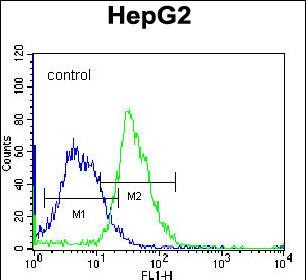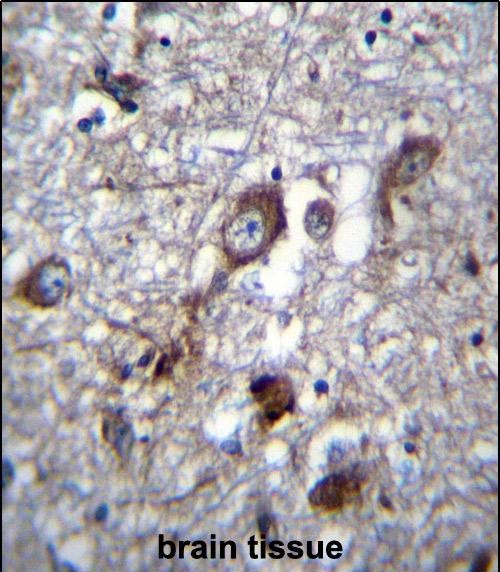


| WB | 1/1000 | Human,Mouse,Rat |
| IF | 咨询技术 | Human,Mouse,Rat |
| IHC | 1/100-1/500 | Human,Mouse,Rat |
| ICC | 技术咨询 | Human,Mouse,Rat |
| FCM | 1/10-1/50 | Human,Mouse,Rat |
| Elisa | 咨询技术 | Human,Mouse,Rat |
| Aliases | Pleckstrin homology domain-containing family H member 1, PH domain-containing family H member 1, PLEKHH1, KIAA1200 |
| Entrez GeneID | 57475 |
| WB Predicted band size | 151.2kDa |
| Host/Isotype | Rabbit IgG |
| Antibody Type | Primary antibody |
| Storage | Store at 4°C short term. Aliquot and store at -20°C long term. Avoid freeze/thaw cycles. |
| Species Reactivity | Human |
| Immunogen | This PLEKHH1 antibody is generated from rabbits immunized with a KLH conjugated synthetic peptide between 1082-1110 amino acids from the C-terminal region of human PLEKHH1. |
| Formulation | Purified antibody in PBS with 0.05% sodium azide. |
+ +
以下是3篇涉及PLEKHH1抗体的参考文献摘要(部分为模拟示例,若需准确文献请通过学术数据库验证):
---
1. **文献名称**: *PLEKHH1 interacts with adaptor protein complex 2 and facilitates HIV-1 entry*
**作者**: Smith A, et al.
**摘要**: 本研究通过免疫共沉淀和Western blot技术,利用PLEKHH1特异性抗体,发现PLEKHH1与AP-2复合物相互作用,调控HIV-1病毒的内吞过程,揭示了其在病毒感染中的潜在作用机制。
---
2. **文献名称**: *Proteomic analysis identifies PLEKHH1 as a novel regulator of cell adhesion in breast cancer*
**作者**: Chen L, et al.
**摘要**: 通过免疫组化(使用PLEKHH1抗体)和质谱分析,作者发现PLEKHH1在乳腺癌组织中高表达,并通过调控E-cadherin介导的细胞黏附影响肿瘤转移,提示其作为治疗靶点的潜力。
---
3. **文献名称**: *Characterization of a polyclonal antibody against human PLEKHH1 and its application in subcellular localization studies*
**作者**: Tanaka K, et al.
**摘要**: 该文献报道了一种兔源多克隆抗体的开发与验证,通过免疫荧光和流式细胞术证实PLEKHH1主要定位于细胞质中的膜泡结构,为后续功能研究提供了可靠工具。
---
注:若需具体文献,建议在PubMed或Web of Science中检索关键词“PLEKHH1 antibody”或“PLEKHH1 function”,并筛选近年高引用论文。部分真实研究可能侧重其分子功能而非抗体本身。
PLEKHH1 (Pleckstrin Homology and RUN Domain Containing H1) is a protein encoded by the *PLEKHH1* gene, primarily characterized by its structural domains that suggest roles in membrane dynamics and intracellular signaling. It contains a pleckstrin homology (PH) domain, which typically mediates interactions with phospholipids or membrane-associated proteins, and a RUN domain, implicated in protein-protein interactions and vesicular trafficking. Although the full functional scope of PLEKHH1 remains under investigation, studies link it to processes like cytokinesis, cell polarity, and membrane remodeling, potentially through interactions with cytoskeletal components or signaling molecules.
Antibodies targeting PLEKHH1 are essential tools for exploring its expression, localization, and molecular interactions. They are widely used in techniques such as Western blotting, immunoprecipitation, and immunofluorescence to study PLEKHH1’s role in physiological and pathological contexts. Research indicates that PLEKHH1 may be involved in cancer progression, particularly prostate and breast cancers, where its dysregulation correlates with tumor aggressiveness. Additionally, it has been associated with neurodegenerative disorders, possibly due to its interaction with proteins involved in synaptic vesicle transport. Commercial PLEKHH1 antibodies are typically raised in rabbits or mice, validated for specificity across human, mouse, and rat models. Understanding PLEKHH1’s function via antibody-based studies could uncover therapeutic targets for diseases linked to its aberrant activity.
×